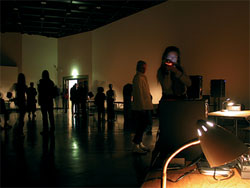Freq_Out

Few musical terms are as evocative today as ‘frequency’. Initially it was simply a mathematical idea that came in handy as musicians started to play with sounds that could not be described within conventional musical notation. But it soon triggered a rich field of imagination that takes its key from the paradoxes that seem to occur between the concrete technology and the atmospheric, the other-worldly, the psychedelic and the contingent sounds it evokes. Such imagination certainly informed the 2002 ‘Frequencies’ exhibition at Frankfurt’s Kunsthalle Schirn.
Freq_Out (2004), a sound installation curated by Carl Michael von Hauswolff and co-produced by Jana Winderen for the Ultima Festival of Contemporary Music in Oslo (with many of the participants from the Frankfurt show), shares this imaginative vision but also provides a double-take on the relationship between sound and spatiality that informs the rather curious phenomenon of the ‘sound exhibition group show’. The point of departure would seem to be the idea of harmonic co-existence, a literal solution to the well-known problem of most group sound exhibitions: the fact that one person’s sound is another’s noise. Or, more precisely, that one person’s evocative resonance is another’s irritant. The limits of your fluid and all-enveloping sonic environment are only really articulated the moment the events that take place in an adjacent territory rub against your own. Why artists who work with sound agree to an exhibition format invented for the plastic arts in the first place is a topic too complex to be discussed in detail here: let’s just say that it makes the spatial parameters of sound legible, and that there are things to be gained from such legibility.
In Freq_Out the problem of territorial division is dealt with, so to speak, by giving each artist a specific frequency range within which to work. Together the 13 contributions cover the range of frequencies that can be registered by the human ear – and then some. Within each frequency range – a sonic ‘territory’ that is represented visually by a work desk and loudspeakers – each artist has total autonomy. There is no unifying principle deciding how the sounds of the individual contributions will be generated, processed or distributed in time. Mike Harding’s wind-generated mid-register sounds – an attempt to create a kind of deep-breathing dynamic – have as little to do with Jim Thirlwell’s condensation of the soundtrack to Wes Craven’s New Nightmare (1994) as they do with Tommi Grönlund and Petteri Nisunen’s subsonic vibrations. Yet conflict is ruled out from the beginning, thanks to the positing of a centrally placed listening position, from which all the sounds are ‘mixed’ into one big, infinitely rich and infinitely variable sound/space sensation.
Here the popular metaphor of the curator – or even better, the participant – as DJ is, so to speak, returned to its origin in non-visual practices. And more than anything this return speaks about the integrating power of all things ‘musical’. Individual differences do not matter, and neither does the fact that a good part of the contributions exist at the fringes of music itself. As Douglas Kahn has pointed out, the outskirts of music are where notions of sound as signification brush against the musical pull towards sonic abstraction. From the ‘mix’ position, however, such potential conflict zones are glossed over. Each detail, each instance of noise and silence, simply contributes to the kind of complex atmospheric and emotional swelling that most of us think of as the very essence of musicality.
It has to be said: as music, Freq_Out provides a hugely enjoyable experience, and it gets better the longer you spend with it, as you gradually become attuned to the variations of this coming together of sound spaces. But it also has to be said that the integrative force of ‘the mix’ soon gives the territorial metaphor a more precise definition: that of a landscape. For this constantly evolving soundscape most of all evokes the kind of uncontrollable change produced by natural phenomena – but viewed as one big sublime process. Most visitors responded by lying down on the floor, as if it was a field, and letting sonic nature wash over them. In view of such blissful happiness the ‘critical’ question may seem a bit cheap: what price territorial harmony?

















